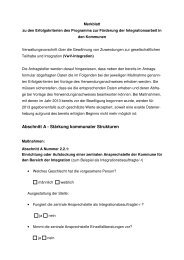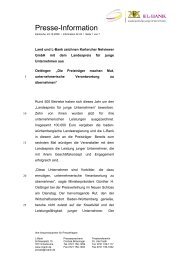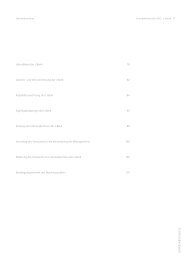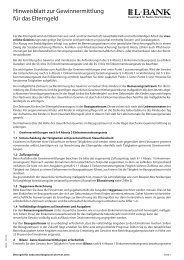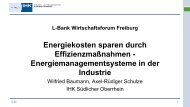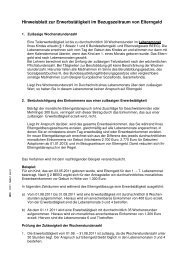Landeskreditbank Baden-Württemberg - L-Bank
Landeskreditbank Baden-Württemberg - L-Bank
Landeskreditbank Baden-Württemberg - L-Bank
You also want an ePaper? Increase the reach of your titles
YUMPU automatically turns print PDFs into web optimized ePapers that Google loves.
SUMMARY OF CERTAIN DIFFERENCES BETWEEN GENERALLY ACCEPTED GERMAN<br />
AND UNITED STATES ACCOUNTING PRINCIPLES<br />
Our audited financial statements for the years ended December 31, 2004, 2003 and 2002 have been prepared<br />
in accordance with generally accepted accounting standards in Germany (“German GAAP”) (see “Regulation<br />
and Supervision of L-<strong>Bank</strong> in the Federal Republic of Germany—Financial Statements and Audits”), which<br />
emphasize the concept of “prudence” (Vorsichtsprinzip) in the presentation of the financial statements in order to<br />
protect the interest of creditors in general. Our financial statements are not prepared in accordance with the<br />
accounting and financial reporting practices followed in the United States and have not been prepared in<br />
accordance with the accounting rules and regulations adopted by the Securities and Exchange Commission under<br />
the Securities Act of 1933. As a result, our financial statements included in this prospectus may differ<br />
substantially from financial statements prepared in accordance with accounting principles generally accepted and<br />
financial reporting practices followed in the United States (“U.S. GAAP”).<br />
The matters described below summarize certain differences between German GAAP and U.S. GAAP at<br />
December 31, 2004 and as of the date of this prospectus that may be material in the context of our financial<br />
statements. We are not required to prepare and have not prepared any reconciliation of our financial statements<br />
and any related footnote disclosures between German GAAP and U.S. GAAP and have not quantified such<br />
differences. The following summary should not be taken as exhaustive discussion of all differences. No attempt<br />
has been made to identify all disclosures, presentation or classification differences that would effect the manner<br />
in which transactions or events are presented in financial statements or notes thereto. In making an investment<br />
decision, investors must rely upon their own examination of the Company, the terms of the offering and the<br />
financial information. Potential investors should consult their own professional advisors for an understanding of<br />
the differences between German GAAP and U.S. GAAP, and how those differences might affect the financial<br />
information herein.<br />
Financial Statements Presentation<br />
Under German GAAP, the components of unconsolidated financial statements are balance sheet, income<br />
statement and notes to the financial statements while for consolidated financial statements, in addition, a<br />
statement of changes in shareholders’ equity and a cash flow statement are required. German GAAP requires one<br />
year of comparatives. The Company is required to use a particular balance sheet and income statement format<br />
and to address in their notes certain disclosures in accordance with the German Commercial Code.<br />
Under U.S. GAAP, financial statements comprise balance sheets, income statements, statements of changes<br />
in shareholders’ equity, cash flow statements and notes to the financial statements for both unconsolidated and<br />
consolidated financial statements. Financial statements for SEC registrants include two years of comparatives (to<br />
the current year) for all statements except for the balance sheet. Material components of each financial statement<br />
or line item have to be disclosed separately and in a sufficient detail in the financial statements including the<br />
notes to the financial statements.<br />
Scope of Consolidation<br />
Under German GAAP, consolidation of all majority-owned subsidiaries is required. However, if the<br />
subsidiaries are of minor significance, the necessary information cannot be obtained without unreasonable<br />
expense or delay and unless the shares are held for purpose of sale or the control is temporary, German GAAP<br />
permits excluding these subsidiaries from the consolidation. Similar considerations apply to equity investments<br />
where significant influence is exercised.<br />
Under U.S. GAAP, the determination when an entity is to be consolidated has traditionally been determined<br />
based on a voting control model and, accordingly, all subsidiaries should be consolidated. While this model is<br />
still applicable, new FASB Interpretation No. 46 ‘Consolidation of Variable Interest Entities’ (“FIN 46”) has<br />
broadened the scope of consolidation to include a risk and rewards model. Variable interest entities (“VIEs”),<br />
81



